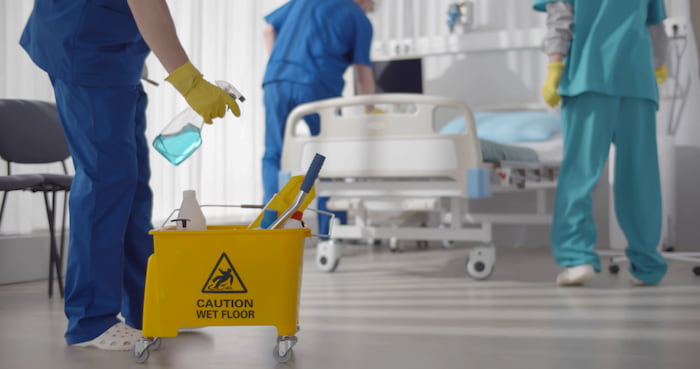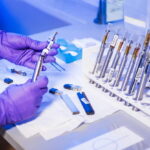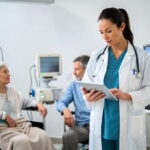Germs from one person can easily be transferred to another, even without direct contact. These can be transmitted by touching an object or surface that isn’t thoroughly cleaned and sanitized. It’s vital in hospitals and other healthcare settings to properly clean and disinfect to avoid spreading germs, bacteria, and viruses, preventing people from getting sick.
Here are the reasons why it’s essential to disinfect in the healthcare industry:
1. To Prevent The Spread Of Unwanted Bacteria
According to Hygieia-San, one of the most significant factors people look for in a hospital, clinic, or laboratory is its cleanliness, hygiene, and sanitation. A clean and sanitized hospital lobby, clinic reception area, and shared bathroom give an excellent impression to patients—and they’ll feel more comfortable using those areas.
It also makes them feel less anxious about getting infected due to airborne diseases and bacteria from surfaces that may compromise their health. It also follows that if the common area is clean and well-maintained, the rooms and the medical services are excellent too. Hospitals and clinics are businesses. It’s essential to give the patients and customers a superb perception so they’d return if needed.
2. To Keep Surfaces Clean For Other Patients And Health Workers
High-touch surfaces are often touched by people that may be easily contaminated and picked up by others using their hands. These include the light switch, door knob, bed rail, bed frame, tray table, IV pole, and other shared equipment.
These are also surfaces in the bathroom like the faucet, toilet, flush handle, bathroom tissue rolls and dispenser, hand dryer, and sink.
Your hands touch many things throughout the day and risk carrying microorganisms that may enter your body like eating without washing your hands.
That’s why cleaning and disinfecting these high-touch surfaces is essential to prevent these microorganisms from spreading, especially after a patient is discharged and another occupies the same room. It’s not only for the patient’s safety but also for the medical practitioners and other workers.
3. To Avoid Transmission Of Infectious Diseases
After every use, medical supplies such as face masks, oxygen masks, syringes, gloves, and bandages must be disposed of. These must be appropriately segregated to avoid contamination and the spread of diseases.
Medical equipment and supplies like stethoscopes, digital thermometers, blood pressure monitors, patient monitors, EKG/ECG machines, defibrillators, X-ray machines, and the like should be cleaned, sanitized, and disinfected after each patient’s use to avoid transfer of germs from one person to another.
Proper cleaning and disinfection also ensure the safety of doctors, nurses, and other medical workers. They’d be able to work without worrying too much about their health.
4. To Ensure That Common Areas, Rooms, Equipment, And Supplies Are Bacteria-Free

Cleaning removes dust, dirt, or other impurities from an object, surface, or environment. Usually, you can already tell if a thing or surface is already clean just by looking at it. But you’re still unsure if it’s free of germs because those microorganisms are too tiny for the naked eye to see.
Remember, bacteria can stay up to five months on a dry surface. That’s why it’s essential to disinfect after cleaning and follow the instructions of the disinfecting products to ensure that germs, bacteria, and viruses will be killed.
Also, be mindful of how long the product or chemical should sit on the object, equipment, or surface to kill the bacteria. Doing a deep cleaning and sanitation is better than risking being sick.
5. Important For The Immune System
When people are healthy, they’re less likely to get sick. Their bodies have ways to fight against infection. However, most patients are ill in hospitals and clinics, and their immune system is weak. They’re more vulnerable to bacteria.
It poses a higher chance for them to acquire more diseases and might bring their health at risk.
That’s why it’s vital to keep the hospitals and clinics clean and disinfected to eliminate or at least lessen the chance of getting an unwanted disease. It’ll only not benefit the patients but the people in the workforce as well.
Final Thoughts
People go to hospitals or clinics to seek medical attention and treatment to feel better and healthier. On the contrary, there’s a risk of going to the hospital as you might have exposure to harmful bacteria and diseases.
But you don’t need to worry since this will be prevented if proper cleaning, sanitation, and disinfection are implemented in clinics and hospitals.
You must always be diligent in selecting the healthcare provider you entrust your health to. Consider the ideas mentioned here as you plan and prepare.
Read Also
- Understanding the Role of Sterilizers in Healthcare FacilitiesHave you ever wondered how hospitals keep their equipment safe enough to use on dozens of patients every day? Most people never think about what happens behind the scenes, yet these hidden steps play a huge role in patient safety. Sterilizers are part of that system, working quietly to remove harmful germs before any instrument… Read more: Understanding the Role of Sterilizers in Healthcare Facilities
- Building Healthcare Access Where It’s Needed Most: A Local First ApproachHealthcare shouldn’t depend on where you live. But in the U.S., it often does. If you’re in a big city, you likely have options. If you’re in a small town or an underserved neighbourhood, it’s a different story. To fix this, more healthcare leaders are turning to a local-first approach. That means putting clinics and… Read more: Building Healthcare Access Where It’s Needed Most: A Local First Approach
- Revolutionizing Patient Engagement: Innovative Solutions for Improved Care and Treatment SuccessNavigating healthcare system can often feel overwhelming for patients. Between appointments, prescriptions, and treatment regimens, it’s easy for crucial details to get lost in the shuffle. That’s why effective patient engagement and support solutions are more important than ever. Companies like Serva Health, with their pharma hub services, are stepping up to ensure that patients… Read more: Revolutionizing Patient Engagement: Innovative Solutions for Improved Care and Treatment Success
- On-Demand Healthcare Staffing As A Cost-Saving StrategyThis is an exciting and challenging time for the healthcare industry. Technology is advancing almost faster than humans can keep pace. New legislation is creating fresh challenges for the future of healthcare, and the shifting population demographic continues to place more pressure on healthcare facilities. Amidst these changes, healthcare facilities are facing a critical staffing… Read more: On-Demand Healthcare Staffing As A Cost-Saving Strategy
- The Benefits of Contract Labor Staffing in HealthcareThe most successful healthcare facilities today aren’t just reacting to crises—they are building workforce resilience to withstand them. Unpredictable patient demand, coupled with persistent nursing shortages, has made the traditional staffing model obsolete. Relying on mandatory overtime to cover a sudden surge in capacity is a recipe for high turnover and rising employee burnout relief… Read more: The Benefits of Contract Labor Staffing in Healthcare






